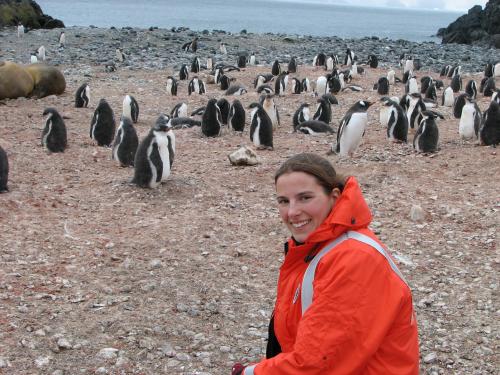Preparing for the Expedition
On February 11th, 2008, I will join the AMLR scientists in Punta Arenas, the southernmost town in Chile. We will then depart on a charted research vessel for the South Shetland Islands off the Antarctic Peninsula for a 32-day cruise. While at sea, we collect environmental, oceanographic, primary productivity and prey (zooplankton abundance and distribution, primarily krill) data from the waters surrounding the South Shetland Islands. Concurrently, AMLR researchers collect predator (seal and seabird) data at two field stations on the South Shetland Islands. This cruise is actually the second cruise of the season. Many of the scientists have been at sea since mid-January and will continue on for this second leg.

Me posing with penguins on last year’s AMLR research cruise.
Because AMLR has been collecting data for so many years, we are able to monitor long-term trends and changes in the Antarctic ecosystem. This year, the scientists on board are reporting high krill abundances, which may have to do with the current La Niña weather regime. While this highly energetic weather system may be great for the krill, it causes all sorts of problems for the scientists.
Antarctica is famous for having the most treacherous seas on earth, and those on board are getting hammered with bad weather. Not only does this make being at sea uncomfortable, but also, rough waters cause all sorts of sampling problems. In the last month, the scientific team has lost valuable and expensive gear, but not to worry, as I am bringing more down south with me. I am hoping the weather turns favorable when the second leg is underway. However, the season will be turning from Austral summer to the fall, with temperatures dropping and stormy seas rising. Of course, all of this is par for the course when working in Antarctica and is what makes the Southern Ocean such an exciting environment to work in. Every year is a new adventure and one I look forward to sharing with you!

 No comments
No comments 






